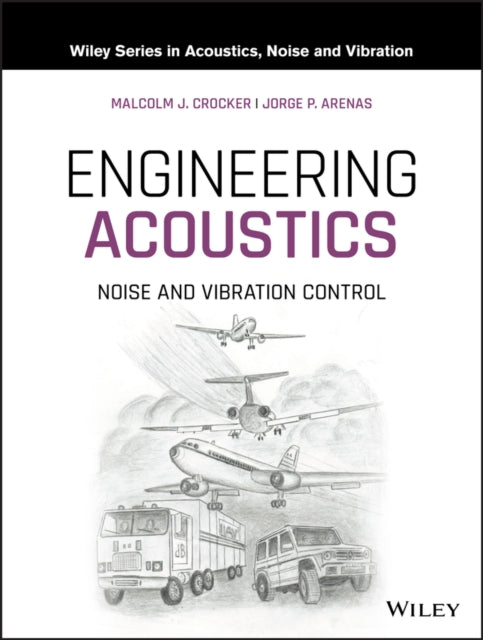Malcolm J. Crocker,Jorge P. Arenas
Engineering Acoustics: Noise and Vibration Control
Engineering Acoustics: Noise and Vibration Control
YOU SAVE £11.93
- Condition: Brand new
- UK Delivery times: Usually arrives within 2 - 3 working days
- UK Shipping: Fee starts at £2.39. Subject to product weight & dimension
Bulk ordering. Want 15 or more copies? Get a personalised quote and bigger discounts. Learn more about bulk orders.
Couldn't load pickup availability
- More about Engineering Acoustics: Noise and Vibration Control
Engineering Acoustics: Noise and Vibration Control is a comprehensive textbook that provides an introduction to the theory of acoustics and methods for controlling noise and vibration in various applications. It covers topics such as human hearing, instrumentation, and measurements, and practical applications of theoretical models. The book includes worked examples, references, and a glossary of terms.
\n Format: Hardback
\n Length: 784 pages
\n Publication date: 13 January 2021
\n Publisher: John Wiley & Sons Inc
\n
In Engineering Acoustics: Noise and Vibration Control, two esteemed experts delve into the intricate realm of acoustics, delving into the concepts of noise and vibration. Through comprehensive and practical insights, the authors elucidate how this theoretical knowledge can be applied to real-world challenges, such as effectively managing noise and vibration in aircraft, automobiles, trucks, machinery, and road and rail vehicles.
Spanning a vast array of topics, this comprehensive textbook encompasses sixteen chapters, each dedicated to exploring key aspects of engineering acoustics. These chapters encompass a diverse range of subjects, including:
Human Hearing and Individual and Community Response to Noise and Vibration: This chapter delves into the intricate mechanisms of human hearing and the responses of individuals and communities to noise and vibration. It explores the effects of noise on human health, productivity, and quality of life, and discusses strategies for mitigating noise pollution.
Noise and Vibration Instrumentation and Measurements: This chapter provides an in-depth exploration of the tools and techniques used to measure and monitor noise and vibration. It covers the selection and application of various instrumentation, such as microphones, accelerometers, and spectrum analyzers, and discusses data analysis and interpretation methods.
Interior and Exterior Noise of Aircraft as Well as Road and Rail Vehicles: This chapter focuses on the sources and control of noise and vibration in aircraft and road and rail vehicles. It discusses the design and construction of noise-reducing materials, such as sound-absorbing materials and silencers, and explores the use of theoretical models to optimize their performance.
Methods for the Control of Noise and Vibration in Industrial Equipment and Machinery: This chapter explores various methods for reducing noise and vibration in industrial equipment and machinery. It covers passive and active noise control techniques, such as vibration isolation, damping, and active control systems, and discusses their practical applications and limitations.
Use of Theoretical Models in Absorptive and Reactive Muffler and Silencer Designs: This chapter discusses the use of theoretical models in designing absorptive and reactive mufflers and silencers. It covers the principles of sound absorption, transmission, and reflection, and explores the design of mufflers and silencers using finite element, boundary element, and statistical energy analysis methods.
Practical Applications of Finite Element, Boundary Element, and Statistical Energy Analysis: This chapter provides practical examples of using finite element, boundary element, and statistical energy analysis methods in engineering acoustics. It showcases how these methods can be employed to simulate and optimize the performance of acoustic systems, such as buildings, vehicles, and machinery.
Sound Intensity Theory, Measurements, and Applications: This chapter delves into the theory of sound intensity and its applications in engineering acoustics. It covers sound intensity measurement techniques, such as sound level meters and dosimeters, and discusses the calculation of sound levels and sound pressure levels in different environments.
Noise and Vibration Control in Buildings: This chapter focuses on the control of noise and vibration in buildings. It discusses the design of noise-reducing materials and structures, such as sound-insulating walls and floors, and explores the use of acoustic treatments, such as acoustic panels and curtains, to mitigate noise transmission.
How to Design Air-Conditioning Systems to Minimize Noise and Vibration: This chapter provides guidance on designing air-conditioning systems to minimize noise and vibration. It covers the selection and configuration of air-conditioning components, such as compressors, fans, and ducts, and discusses the use of noise-reducing technologies, such as vibration isolation and damping.
Throughout the textbook, readers are provided with numerous worked examples and practical applications to reinforce the theoretical concepts. Additionally, each chapter concludes with a comprehensive list of references to support further reading on specific topics, enhancing the learning experience.
Furthermore, the book features a detailed index and a glossary of terms in acoustics, noise, and vibration, making it an invaluable resource for students, professional engineers, and community planners alike.
In summary, Engineering Acoustics: Noise and Vibration Control offers a comprehensive and practical introduction to the theory and applications of acoustics, noise, and vibration. By presenting a wealth of knowledge and expertise, the book empowers readers to address real-world challenges and optimize acoustic systems for a better and more comfortable environment.
\n Weight: 1894g\n
Dimension: 211 x 261 x 51 (mm)\n
ISBN-13: 9781118496428\n \n
This item can be found in:
UK and International shipping information
UK and International shipping information
UK Delivery and returns information:
- Delivery within 2 - 3 days when ordering in the UK.
- Shipping fee for UK customers from £2.39. Fully tracked shipping service available.
- Returns policy: Return within 30 days of receipt for full refund.
International deliveries:
Shulph Ink now ships to Australia, Belgium, Canada, France, Germany, Ireland, Italy, India, Luxembourg Saudi Arabia, Singapore, Spain, Netherlands, New Zealand, United Arab Emirates, United States of America.
- Delivery times: within 5 - 10 days for international orders.
- Shipping fee: charges vary for overseas orders. Only tracked services are available for most international orders. Some countries have untracked shipping options.
- Customs charges: If ordering to addresses outside the United Kingdom, you may or may not incur additional customs and duties fees during local delivery.


